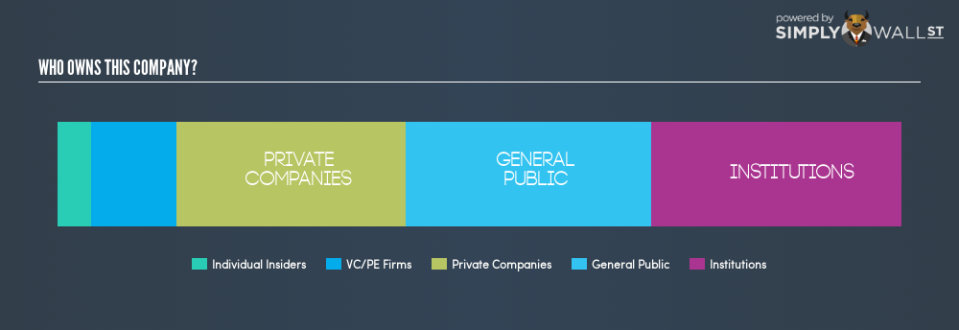Who Are The Largest Shareholders In Polymetal International Plc (LON:POLY)?

In this analysis, my focus will be on developing a perspective on Polymetal International Plc’s (LON:POLY) latest ownership structure, a less discussed, but important factor. A company’s ownership structure is often linked to its share performance in both the long- and short-term. Differences in ownership structure of companies can have a profound effect on how management’s incentives are aligned with shareholder returns, which is why we’ll take a moment to analyse POLY’s shareholder registry.
See our latest analysis for Polymetal International
Institutional Ownership
POLY’s 29.53% institutional ownership seems enough to cause large share price movements in the case of significant share sell-off or acquisitions by institutions, particularly when there is a low level of public shares available on the market to trade. Although POLY has a high institutional ownership, such stock moves, in the short-term, are more commonly linked to a particular type of active institutional investors – hedge funds. For POLY shareholders, the potential of this type of share price volatility shouldn’t be as concerning as hedge fund ownership is is not significant,indicating few chances of such sudden price moves. While that hardly seems concerning, I will explore further into POLY’s ownership type to find out how it can affect the company’s investment profile.
Insider Ownership
I find insiders are an important group of stakeholders, who are directly involved in making key decisions related to the use of capital. In essence, insider ownership is more about the alignment of shareholders’ interests with the management. POLY insiders may only hold a 4.14% stake in the company, but this is a relatively significant holding given it is a large-cap stock. A higher level of insider ownership has been linked to management executing on high-returning projects instead of expansion projects for the sake of apparent growth. I will also like to check what insiders have been doing recently with their holdings. Insider buying may be a sign of upbeat future expectations, however, selling doesn’t necessarily mean the opposite as insiders may be motivated by their personal financial needs.
General Public Ownership
A substantial ownership of 29.13% in POLY is held by the general public. This level of ownership gives retail investors the power to sway key policy decisions such as board composition, executive compensation, and potential acquisitions. This is a positive sign for an investor who wants to be involved in key decision-making of the company.
Private Equity Ownership
With an ownership of 10.10%, private equity firms are a major stakeholder in POLY and are in a position to play an important role in shaping up corporate strategy with a focus on value creation. An investor should be encouraged by the ownership of these institutions who are known to be experts in increasing efficiency, improving capital structure and opting for value-accretive policy decisions.
Private Company Ownership
Another group of owners that a potential investor in POLY should consider are private companies, with a stake of 27.11%. While they invest more often due to strategic interests, an investment can also be driven by capital gains through share price appreciation. An ownership of this size indicates a strong financial backing and has the potential to influence POLY’s business strategy. Thus, investors should dig deeper into POLY’s business relations with these companies and how it can affect shareholder returns in the long-term.
Next Steps:
The company’s high institutional ownership makes margin of safety a very important consideration to existing investors since long bull and bear trends often emerge when these big-ticket investors see a change in long-term potential of the company. This will enable shareholders to comfortably invest in the company while avoid getting trapped in a sustained sell-off that is often observed in stocks with this level of institutional participation. However, ownership structure should not be the only focus of your research when constructing an investment thesis around POLY. Rather, you should be examining fundamental factors such as the intrinsic valuation, which is a key driver of Polymetal International’s share price. I urge you to complete your research by taking a look at the following:
Future Outlook: What are well-informed industry analysts predicting for POLY’s future growth? Take a look at our free research report of analyst consensus for POLY’s outlook.
Past Track Record: Has POLY been consistently performing well irrespective of the ups and downs in the market? Go into more detail in the past performance analysis and take a look at the free visual representations of POLY’s historicals for more clarity.
Other High-Performing Stocks: Are there other stocks that provide better prospects with proven track records? Explore our free list of these great stocks here.
NB: Figures in this article are calculated using data from the last twelve months, which refer to the 12-month period ending on the last date of the month the financial statement is dated. This may not be consistent with full year annual report figures.
To help readers see past the short term volatility of the financial market, we aim to bring you a long-term focused research analysis purely driven by fundamental data. Note that our analysis does not factor in the latest price-sensitive company announcements.
The author is an independent contributor and at the time of publication had no position in the stocks mentioned. For errors that warrant correction please contact the editor at editorial-team@simplywallst.com.

